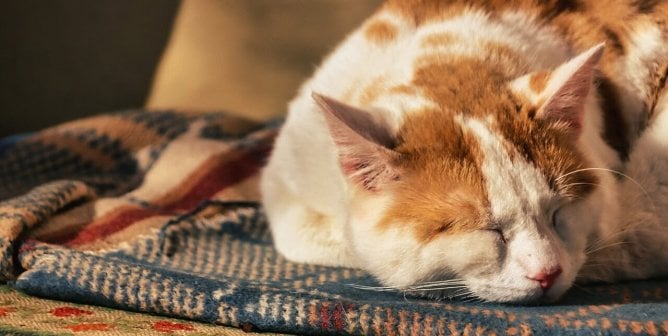Many people admire birds for their brilliant colors, intelligence, ability to communicate, and graceful aerial skills. Unfortunately, because of this, people end up keeping birds as “pets” in lonely, boring cages. Deprived of many of the things that are natural and important to them, such as flying with their flockmates, exploring, and choosing a mate, many caged birds become depressed or neurotic, pulling out feathers and mutilating themselves—sometimes severely, irreversibly, even to the point of death. Other birds are abandoned after their guardians discover that bird behaviors, such as flock-calling, biting, chewing, and throwing food don’t fit in well with a human home environment.
Please, resist the temptation to buy a bird as a companion. If you already have a bird, please read on to learn more about these complex animals and how you can make their lives as healthy, happy, and fulfilling as possible.
No Bird Is an Island
Companionship is crucial for birds’ well-being. If you have a single bird, adopt a companion of the same or similar species. Check shelters, humane societies, animal rights groups, nursing homes (some birds can live for more than 100 years and outlive their human companions), avian veterinarians, or the list of avian rescue organizations at avianwelfare.org.
Before introducing a new bird, take him or her to an avian veterinarian for a checkup. If the newcomer is healthy and free of diseases, put his or her cage inside or next to the larger flight enclosure so that the birds can see each other without coming into direct contact with one another. Watch to see how the birds get along for at least one week. If they seem friendly to each other, allow the birds to visit—supervised—using separate playstands. Once you are confident that the birds pose no threat to one another, open the door of the small cage. The newcomer will come out when he or she feels comfortable enough.
Leave this cage in place, door open, so the newcomer may use it as a safe place—the resident bird should also have a large flight cage of his or her own to use as a private room. Until you’re absolutely sure that the birds have bonded, do not leave them alone together. Don’t assume that these two birds will definitely become friends—be prepared to house the birds separately if they do not bond.
Free as a Bird
Let your birds fly free for long periods of time every day—spending as much time out of the cage as possible. Convert your balcony or porch into an aviary or build a good-weather aviary in your backyard if possible. Or provide a bird-proof room or rooms, with no ceiling fans or other bird hazards. Include a bird “gym” or nonpoisonous tree branches (such as dogwood, apple, or elm) for exercise. Large “flight cages” can allow your birds to exercise when you can’t be there to supervise them.
Provide numerous bird-safe toys (available from companion-animal supply companies) for chewing, playing, and intellectual stimulation including clean, nonpoisonous wood. Birds should get between eight and 12 hours of sleep a night, preferably from dusk on, in a dark, quiet room, a draped flight enclosure, or a covered cage.
Birds Can’t Live on Seeds Alone
Wild birds don’t eat just seeds, so keep your bird’s diet varied and nutritious by offering a variety of fruits and vegetables along with grains, nuts, cooked beans, and seeds. Different species have different nutritional needs, so it’s imperative to research your bird’s diet or consult with an avian veterinarian. Malnutrition accounts for more than 90 percent of the health problems of companion birds.
Birds need the proper combination of vitamins, minerals, and amino acids to stay healthy. A good pellet-based diet can help, but feeding a variety of the proper foods should meet all your birds’ needs.
Keep food and water containers above perches, so they do not get soiled with droppings. Soiled containers must be cleaned immediately. Some birds dunk their food in water, and those water containers should be cleaned at least twice a day to prevent bacterial growth. Vitamins should never be administered through the water.
Never give grit to a parrot. Grit has no place in a parrot’s diet—it can mineralize in the gizzard and cause painful crop impactions. Grit is only necessary in the diet of birds who eat seeds whole, such as canaries and doves.
Time to Preen
Your birds might spend hours every day combing their feathers with their beaks. This helps keep their feathers in line and waterproof. To encourage preening, provide shallow containers or a birdbath filled with water. Some birds like to be misted with water from a spray bottle set to a fine mist. After your birds bathe, keep them away from drafts until their feathers are totally dry.
Beak trims should not be needed unless there is an underlying health problem. Overgrown nails or beaks require a trip to a good avian veterinarian.
Bird-Proofing Your ‘Nest’
Before allowing your bird to fly free, eliminate or cover up hazards like ceiling fans, pots of water, open toilet bowls, electrical wires, large glass windows and mirrors, and places where birds could become stuck. Make sure that your plants are not poisonous to birds. Common plants that are toxic if birds eat them include English ivy, philodendron, azaleas, and holly. A good avian veterinarian can provide you with an extensive list.
Birds have very fragile respiratory systems. Overheated nonstick cookware and self-cleaning ovens emit fumes that are deadly to birds—never use them in a home with birds. Use ecologically safe products—no bleach or strong cleaners, aerosols, artificial air fresheners, scented candles, incense, or insecticides. Cigarette smoke should never be allowed around birds. If your apartment complex demands that you make your apartment available to an exterminator, you can legally refuse for health reasons.
If you or people you know already have birds and are unable to meet their needs, please consider the following options:
- Find out if there is a reputable bird sanctuary or large indoor/outdoor aviary (or an outdoor one in a very warm climate) to which you can surrender the bird. Ideally, you should place non-aggressive birds with members of their own species or family. Consider the climate, opportunities for socialization and privacy, and other key factors such as diet, exercise and enrichment opportunities, cleanliness, and access to veterinary care.
- If you cannot find a reputable sanctuary, consider placing the bird with someone who has other birds of the same species, allows them to live in a free-flight situation, and will never separate them once they have bonded. Also, make sure that they use a board-certified avian veterinarian and do not breed birds.
For more information on keeping birds as companions, please visit the Avian Welfare Coalition’s Web site at AvianWelfare.org.






